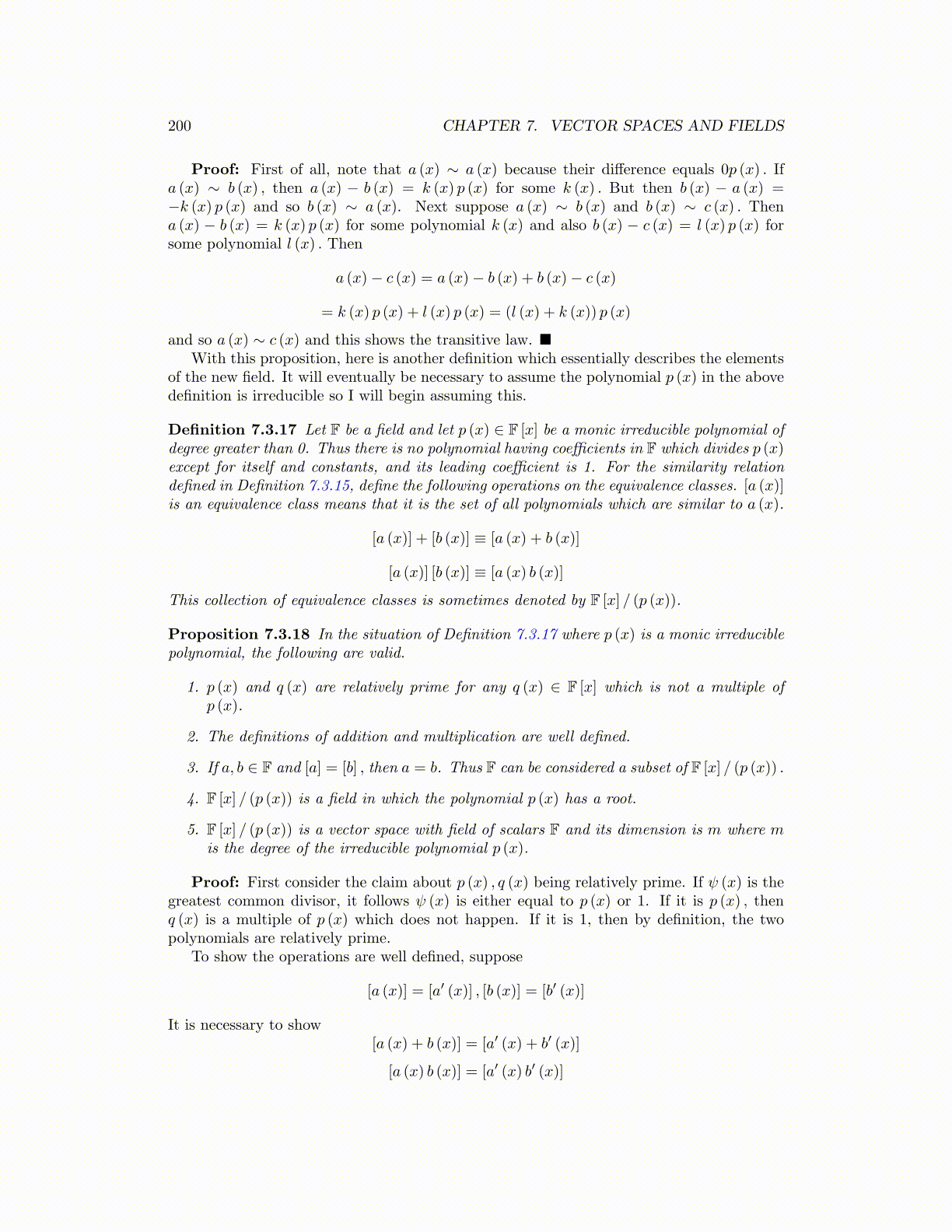
200 CHAPTER 7. VECTOR SPACES AND FIELDS
Proof: First of all, note that a (x) ∼ a (x) because their difference equals 0p (x) . Ifa (x) ∼ b (x) , then a (x) − b (x) = k (x) p (x) for some k (x) . But then b (x) − a (x) =−k (x) p (x) and so b (x) ∼ a (x). Next suppose a (x) ∼ b (x) and b (x) ∼ c (x) . Thena (x) − b (x) = k (x) p (x) for some polynomial k (x) and also b (x) − c (x) = l (x) p (x) forsome polynomial l (x) . Then
a (x)− c (x) = a (x)− b (x) + b (x)− c (x)
= k (x) p (x) + l (x) p (x) = (l (x) + k (x)) p (x)
and so a (x) ∼ c (x) and this shows the transitive law. ■With this proposition, here is another definition which essentially describes the elements
of the new field. It will eventually be necessary to assume the polynomial p (x) in the abovedefinition is irreducible so I will begin assuming this.
Definition 7.3.17 Let F be a field and let p (x) ∈ F [x] be a monic irreducible polynomial ofdegree greater than 0. Thus there is no polynomial having coefficients in F which divides p (x)except for itself and constants, and its leading coefficient is 1. For the similarity relationdefined in Definition 7.3.15, define the following operations on the equivalence classes. [a (x)]is an equivalence class means that it is the set of all polynomials which are similar to a (x).
[a (x)] + [b (x)] ≡ [a (x) + b (x)]
[a (x)] [b (x)] ≡ [a (x) b (x)]
This collection of equivalence classes is sometimes denoted by F [x] / (p (x)).
Proposition 7.3.18 In the situation of Definition 7.3.17 where p (x) is a monic irreduciblepolynomial, the following are valid.
1. p (x) and q (x) are relatively prime for any q (x) ∈ F [x] which is not a multiple ofp (x).
2. The definitions of addition and multiplication are well defined.
3. If a, b ∈ F and [a] = [b] , then a = b. Thus F can be considered a subset of F [x] / (p (x)) .
4. F [x] / (p (x)) is a field in which the polynomial p (x) has a root.
5. F [x] / (p (x)) is a vector space with field of scalars F and its dimension is m where mis the degree of the irreducible polynomial p (x).
Proof: First consider the claim about p (x) , q (x) being relatively prime. If ψ (x) is thegreatest common divisor, it follows ψ (x) is either equal to p (x) or 1. If it is p (x) , thenq (x) is a multiple of p (x) which does not happen. If it is 1, then by definition, the twopolynomials are relatively prime.
To show the operations are well defined, suppose
[a (x)] = [a′ (x)] , [b (x)] = [b′ (x)]
It is necessary to show[a (x) + b (x)] = [a′ (x) + b′ (x)]
[a (x) b (x)] = [a′ (x) b′ (x)]